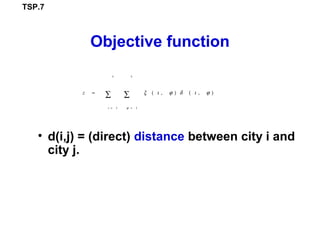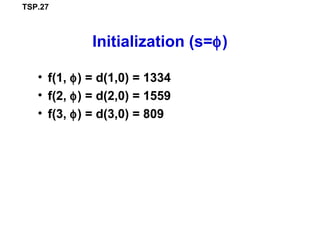Chapter9 4
- 1. TSP.1 9.4 Travelling Salesperson Problem (TSP) • Very famous problem • Many practical applications • Very easy to describe • Very difficult to solve (Curse of Dimensionality) • We shall consider the dynamic programming (DP) approach • Other approaches: see 620-362
- 2. TSP.2 Problem Formulation • There are many ways to describe this problem. • We shall consider the following: – English version – Linear Programming oriented version – Linear Programming Free version – Dynamic programming version
- 3. TSP.3 English Version • You are given a set of n cities • You are given the distances between the cities • You start and terminate your tour at your home city • You must visit each other city exactly once. • Your mission is to determine the shortest tour.
- 4. TSP.4 Maths versions • We shall consider two Maths Version • The first is LP-based • The second is LP-free • The first version dominates the OR literature
- 5. TSP.5 TSP Version 1 (LP) • Decision variable: A boolean matrix x interpreted as follows: x(i,j):= 1, iff we go from city i to city j. x(i,j) := 0, otherwise
- 6. TSP.6 Example • This matrix represents the tour (1,2,3,4,1) x = 0 1 0 0 0 0 1 0 0 0 0 1 1 0 0 0
- 7. TSP.7 Objective function • d(i,j) = (direct) distance between city i and city j. z = ξ ( ι , ϕ ) δ ( ι , ϕ ) ϕ = 1 ν ∑ ι = 1 ν ∑
- 8. TSP.8 Constraints • Each city must be “exited” exactly once • Each city must be “entered” exactly once x ( i , j ) j = 1 ν ∑ = 1 , ι = 1 , 2 , ..., ν x ( i , j ) i = 1 ν ∑ = 1 , ϕ = 1 , 2 , ..., ν
- 9. TSP.9 Is this enough ?
- 10. TSP.10 No! • The first two constraints allow sub- tours • Thus, we have to add a constraint that will prevent sub-tours
- 11. TSP.11 Explanation: sub-tours • Two subtour: (1,2,1) and (3,4,3) • This solution is not feasible for the TSP x = 0 1 0 0 1 0 0 0 0 0 0 1 0 0 1 0
- 12. TSP.12 • If we start at the home city n=1, we will not visit city 3 and 4. • We must go from city 2 to either city 3 or city 4. 1 2 3 4
- 13. TSP.13 Subtour elimination constraint • S = subset of cities • |S| = cardinality of S (# of elements in S) • There are 2n such sets !!!!!!! x ( i , j ) ≤ Σ ι , ϕ ∈ Σ ∑ − 1 , ∀ Σ ⊂ { 1 , 2 , ..., ν }
- 14. TSP.14 Example • Consider S={1,2}, |S|=2 x = 0 1 0 0 1 0 0 0 0 0 0 1 0 0 1 0 x ( i , j ) = 2 ι , ϕ ∈ Σ ∑ • Hence the sub-tour elimination constraint is not satisfied. • Indeed, thee are two subtours in this solution
- 15. TSP.15 Thus, LP Version min x x ( i , j ) d ( i , j ) j = 1 ν ∑ ι = 1 ν ∑ σ . τ. ξ ( ι , ϕ) = 1 , ι = 1 , 2 , ..., ν ϕ = 1 ν ∑ ξ ( ι , ϕ) = 1 , ϕ = 1 , 2 , ..., ν ι = 1 ν ∑ ξ ( ι , ϕ) ≤ Σ − 1 , ∀ Σ ⊂ { 1 , 2 , ..., ν } ι , ϕ∈ Σ ν ∑ ξ ( ι , ϕ) ∈ { 0 , 1 }
- 16. TSP.16 LP-Free Version • Decision variables: xj := j-th city on the tour, j=1,2,…,n • Example: • x=(1,3,2,4,1) • We start at city 1, then go to city 3, then go to city 2 then go to city 4 then return to city 1.
- 17. TSP.17 ASSUMPTION • Assume that 0 is the home city, and that there are n other cities
- 18. TSP.18 Objective function z = δ ( 0 , ξ 1 ) + δ ( ξ ϕ ϕ = 1 ν − 1 ∑ , ξ ϕ + 1 ) + δ ( ξ ν , 0 )
- 19. TSP.19 Constraints • The constraint basically says that x is a permutation of the cities (1,2,3, …,n) • Make sure that you appreciate the role of { } in this formulation. x 1 , ..., x n { } = { 1 , 2 , 3 , ..., ν }
- 20. TSP.20 LP-Free Formulation • There are n! feasible solutions x 1 , ..., x n { } = { 1 , 2 , 3 , ..., ν } min x d ( 0 , x 1 ) + δ ( ξ ϕ ϕ = 1 ν − 1 ∑ , ξ ϕ + 1 ) + δ ( ξ ν , 0 )
- 21. TSP.21 Which one do you prefer?
- 22. TSP.22 LP Version min x x ( i , j ) d ( i , j ) j = 1 ν ∑ ι = 1 ν ∑ σ . τ. ξ ( ι , ϕ) = 1 , ι = 1 , 2 , ..., ν ϕ = 1 ν ∑ ξ ( ι , ϕ) = 1 , ϕ = 1 , 2 , ..., ν ι = 1 ν ∑ ξ ( ι , ϕ) ≤ Σ − 1 , ∀ Σ ⊂ { 1 , 2 , ..., ν } ι , ϕ∈ Σ ν ∑ ξ ( ι , ϕ) ∈ { 0 , 1 }
- 23. TSP.23 LP Free Version x 1 , ..., x n { } = { 1 , 2 , 3 , ..., ν } min x d ( 0 , x 1 ) + δ ( ξ ϕ ϕ = 1 ν − 1 ∑ , ξ ϕ + 1 ) + δ ( ξ ν , 0 )
- 24. TSP.24 DP Solution • Let, f(i,s) := shortest sub-tour given that we are at city i and still have to visit the cities in s (and return to home city) Then clearly, f (i,φ) = d(i,0), φ = empty set f (i,s) = min j ∈S d(i, j) + f (j,s {j}){ }, s ≠ φ s A:= {k ∈ s,k ∉ A}.
- 25. TSP.25 Explanation • Then clearly, ….. (i,s) We are at city i and still have to visit the cities in s Suppose we decide that from here we go to city j Then we shall travel the Distance d(i,j) (j,s{j}) We are now at city j and still have to visit the cities in s{j} f (i,φ) = d(i,0), φ = empty set f (i,s) = min j ∈S d(i, j) + f (j,s {j}){ }, s ≠ φ s A := {k ∈ s,k ∉ A}.
- 26. TSP.26 Example (Winston, p. 751) • Distance (miles) • Cities: New York, Miami, Dallas, Chicago d = − 1334 1559 809 1334 − 1343 1397 1559 1343 − 921 809 1397 921 − ⎡ ⎣ ⎢ ⎢ ⎢ ⎤ ⎦ ⎥ ⎥ ⎥
- 27. TSP.27 Initialization (s=φ) • f(1, φ) = d(1,0) = 1334 • f(2, φ) = d(2,0) = 1559 • f(3, φ) = d(3,0) = 809
- 28. TSP.28 Iteration (on, i and s) • We shall generate s systematically by its “size”. • Size = 1: Possible values for s: {1}, {2}, {3}. • s = {1} : f(2,{1})= ? ; f(3,{1})= ? • s = {2} : f(1,{2})= ? ; f(3,{2})= ? • s = {3} : f(1,{3})= ? ; f(2,{3})= ?
- 29. TSP.29 |s|=1 f(i,{j}) = d(i,j)+f(j, φ) • f(2,{1})= d(2,1) + f(1,φ) = 1343 + 1334 = 2677 • f(3,{1})= d(3,1) + f(1,φ) = 1397 + 1334 = 2731 • f(1,{2})= d(1,2) + f(2,φ) = 1343 + 1559 = 2902 • f(3,{2})= d(3,2) + f(2,φ) = 921 + 1559 = 2480 • f(1,{3})= d(1,3) + f(3,φ) = 1397 + 809 = 2206 • f(2,{3})= d(2,3) + f(3,φ) = 921 + 809 = 1730
- 30. TSP.30 |s| = 2 f(i,s)= min{d(i,j)+f(j,s{j}): j in s} • Size = 2: Possible values for s: {1,2}, {1,3}, {2,3} Thus, we have to determine the values of • f(3,{1,2}) = ? ; f(2,{1,3}) = ? ; f(1,{2,3}) = ? • Eg: f(3,{1,2}) = min {d(3,j) + f(j,s{j}): j in {1,2} } = min {d(3,1) + f(1,{2}) , d(3,2) + f(2,{1})} = min {1397+2902,921+2677} = min {4299,3598} = 3598 , N(3,{1,2})={2}
- 31. TSP.31 |s| = 3 • In this case there is only one feasible s, namely s={1,2,3}. • Thus, there is only one equation to solve, namely for i=0, s={1,2,3}. The value of f(0,{1,2,3}) is the shortest tour. • Note that in this case • f(0,{1,2,3})=min {d(0,j) + f(j,{1,2,3}{j}: j in {1,2,3} • = min {d(0,1)+f(1,{2,3}), d(0,2)+ f(2,{1,3}), d(0,3)+f(3, {1,2})} • =min {1334+3073, 1559+3549, 809 + 3598} • = min {4407,5108,4407} = 4407, N(0,{1,2,3})={1,3}
- 32. TSP.32 Recovery • S=(0,{1,2,3}), N(s)={1,3} , c=1 • S={1,{2,3}}, N(s)={2}, c=(1,2) • S={2,{3}}, N(s)={3}, c=(1,2,3). • Hence: x*=(0,1,2,3,0), z*=4407
































